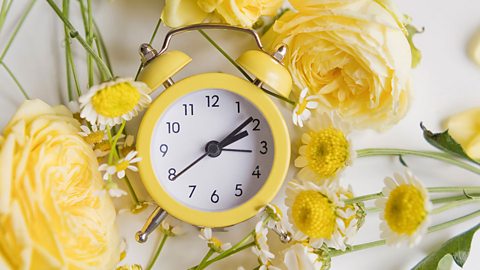
When do the clocks go forward?
On Sunday 31st March, the clocks 'spring forward' by one hour, marking the annual move from Greenwich Mean Time (GMT) to British Summer Time (BST).
The first BST clock change happened over 100 years ago in 1916, but the changes still confuse people each year. So, we aim to clear up any confusion about what time the clocks change, whether our moods improve, and find out if Stonehenge really gets re-arranged when the clocks go forward!

Myths about the clocks going forward

People are often confused (or forget!) about the exact time that clocks change, is it midnight, 1am or 2am? Thankfully, we can clear this one up quite easily. The clocks go forward at 1am on the last Sunday of March, and they go back one hour at 2am in autumn.
Sadly, for those of us who like a lie-in, the clock change in spring does mean we get one hour less sleep. But don't worry, most mobile phones automatically adjust at 1am, so your alarm will switch too – you've got no excuse for being late to breakfast!
Remember, there are lots of fun things you can do to make the most of that extra hour of daylight!

The evenings start to get lighter after the shortest day, which is usually December 21st or 22nd, but we see the biggest increase in daylight when the clocks go forward in March. So, although days have been gradually getting longer for a few months, many of us will start to feel the benefits of the extra daylight in the evenings once the clocks change, including more sunlight (fingers crossed!).
According to the NHS, a lack of sunlight may lead to lower serotonin levels, which is linked to feelings of depression, but getting outside, especially if exercising, has many mood-boosting benefits. So, why not put on some sun cream and spend that extra hour of daylight with your mates in the great outdoors!

The world famous stone circle, Stonehenge in Wiltshire, is thousands of years old. Historians say that it was built to align with the sunrise on the summer solstice – the longest day – with thousands of people gathering on the longest day, usually June 20th or 21st, to see the phenomenon. But the rumours that Stonehenge was moved to line up with the hour change simply aren't true.
The photographs that helped to spark the rumours were actually taken in 1919 when vital conservation work was carried out on the world famous stones. We can well and truly put this myth to bed(rock)!

Not sure if the news you’re seeing on social media is true or false? Can you always tell if the things you see online are real or fake? Learn how to get the other side of the story with our quizzes, videos and explainers.


